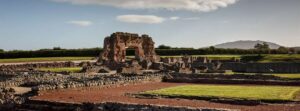Abiding by beauty industry standards, a clean body free of hair is the ultimate goal for one to reach. But have you ever thought, who were the first men and women to set such marks for the rest of the world to believe? British archaeologists have found a suitable answer after excavating multiple tweezers dating back to a Roman town as large as Pompeii. The people of the Roman Empire from Wroxeter City used these tweezers to remove their armpit hair.
Beauty Is Pain – The Roman Empire Establishing No Body Hair Trend
Archaeologists have found a collection of 50+ pairs of tweezers from the ruins at the Wroxeter Roman City of Shropshire. The items date back to the 2nd and 4th centuries (AD).
There were among 400 artifacts related to Roman beauty practices and cleanliness. Some of them are,
- A strigil (skin scraper)
- Jewelry made of jet and bone
- Perfume bottles
- Make-up applicators
- And amulets that can ward off evil or help women with their health and fertility.
Also, further studies suggest that the Romans were obsessed with their cleanliness and focused on maintaining a public image. Which would separate them from the ‘barbarians.’

Because communal bathing was a part of their daily lives, many Romans had their own cleaning sets – personal nail cleaners, tweezers, and an ear scoop. Isn’t that amazing?
However, the elites had slaves do all the work, helping with hair plucking. A letter by the Roman politician and author Seneca to his friend had the former complaining about the annoying noise from the public baths. Where he did write about the noise made by the skinny hair plucker. According to the author, “the hair plucker made all these shrill noises to draw public attention and only used to stop when working and making someone else cry out of pain.”
A Look Into The Wroxeter Roman City (or Viriconium Cornoviorum)
As per Archaeological excavations, the Wroxeter Roman City is the best-preserved example of the past, highlighting the social attributes of the people living in the Roman Empire at that time. Historians have found monumental buildings at the city’s heart – the market (where shoppers bought all the goods), the forum (where laws were made), and the bath house ‘basilica.’ The bathhouse was used as a community center, place of education, and shopping center. Also, there were townhouses, serving as homes of the wealthy citizens.

The town and its surviving ruins are still visible for historians to decipher the people’s living conditions of that time.
After thorough analysis and excavation, some of the remarkable items from the site are now part of the Wroxeter city museum. This includes figurines of Gods and Goddesses from the era, and Roman water pipes, which would have served the bathing house. Along with these – copper alloy cosmetic sets, bath oil, eyeliner & eye shadow, and 1000 jewelry beads restructured into necklaces.
Why Was Wroxeter Roman City Abandoned?
The Wroxeter Roman City’s example helped historians discover the people’s social, economic, and political life from the past. How Britain and the Roman Empire at that time became subject to external pressure and internal conflicts and walked into a path of instability. Also, the empire was in a state of inflation. The existing army could no longer conquer new lands, and the state was paying for the regular whereabouts, which would not last long.
The historical ruins found at the site had massive public buildings. Archeologists believe these were expensive and difficult to maintain. Thus with time, people started abandoning them towards the end of the 4th Century AD. With inflation at its peak, people left the Wroxeter Roman City.



